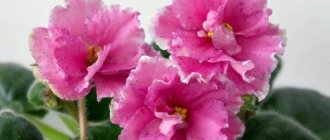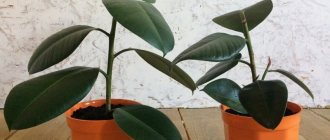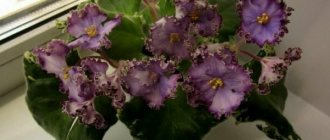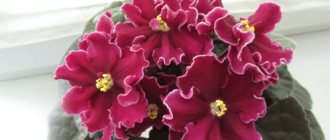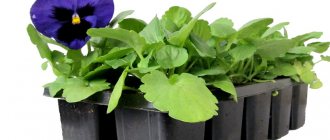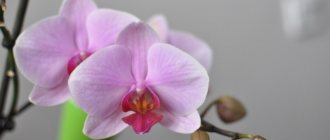The “Dance of Galaxies” variety was created on the basis of field violets by breeder Konstantin Morev. Its peculiarity is lilac petals with dotted inclusions of white.
Dear readers! For you, we have created communities on social networks in which useful articles and interesting ideas are published several times a day! Subscribe and receive useful content in a convenient format!
The edges are represented by a crystal white border. Dark green smooth leaves perfectly complement the composition. “Dance of the Galaxy” is unpretentious, which allows you to grow it at home.
Growing rules
Like all violets, “Dance of the Galaxy” is a rather whimsical and capricious variety.
In unfavorable conditions, the plant's leaves quickly turn yellow and it dies. Therefore, it is very important to adhere to the following recommendations
Selecting a location
Violets need a well-lit place. The ideal place would be a slightly shaded window that receives diffused sunlight.
In rooms where there is a lack of natural light, lamps can be used.
The level of air humidity also matters.
If the room is too dry, violets stop flowering.
Important! Violets should not be placed in a place exposed to direct sunlight. Under their influence, the plant develops burns on the leaves and may die.
Choosing a pot
The pot in which the Galaxy Dance violet will grow also plays an important role.
When choosing an unsuitable container, there is a risk that the flower will quickly begin to hurt, flowering will stop, the leaves will begin to turn yellow and rot.
To prevent this from happening, it is important to pay attention to choosing the right pot
First you need to decide on the size of the container. The roots of violets do not grow deeply; they are located closer to the soil surface, because need light and nutrients. Therefore there is no need for deep pots.
In addition, it is very important to consider the size of the plant. Expert opinion
Expert opinion
Nesterova Olga Nikolaevna
Specialist in landscaping, master of landscape design. Indoor floriculture consultant
Violet is one of the few plants that thrives in a cramped pot. For planting a large flower, a pot with a height of about 10 centimeters is suitable. For a medium-sized violet, a pot 7 centimeters high works well. If you plan to plant a young plant or mini-violet, it is recommended to choose a container with a diameter of 5 centimeters.
The diameter of the pot should match its height. Containers that are too wide or deep can cause the death of the flower.
The material from which the pot is made is also important. Most often, the following materials are used to make containers:
Plastic – plastic pots often attract attention with their bright colors and cute shapes. However, a plastic pot is not the best option for violets. The paint used to paint the pot contains substances that have a detrimental effect on the root system of the flower.
Because plastic prevents the flow of air; when planting violets in such a pot, it is necessary to make drainage holes. This will avoid rotting of the root system;
Clay - violets feel quite comfortable in clay pots, because... clay is a natural material that is highly permeable to air and moisture. However, clay pots are often quite fragile. Fired clay pots are more reliable because... When exposed to high temperatures, a clay product gains strength. Ceramic pots are also a good option because... ceramics is the same clay that has undergone heat treatment. Such pots can be coated with a special glaze that prevents air from entering. Pots that are not glazed may crack and crumble over time, and in addition, stains from water and salts become visible on them. Despite this, violets do well in ceramic pots that are not glazed.
Soil selection
The soil for violets, including the “Dance of the Galaxy” variety, must be enriched with the necessary nutrients. The soil must be well-permeable to oxygen to prevent rotting of the root system.
Watering
It is recommended to water the violet with settled water, the temperature of which is no more than 25 degrees.
It is allowed to pour water into the pan to keep the soil well moistened.
The “Dance of Galaxies” violet loves humidity, so it is advisable to periodically spray the flower with water from a spray bottle.
Important! Watering a plant with too cold or warm tap water can lead to disease and death of the flower.
Temperature
For good growth and flowering, violets require a room temperature not exceeding 22 degrees.
Slight fluctuations in temperature are allowed, but it is important that the thermometer mark does not fall below 18 degrees
Feeding
If the soil is properly selected, there is no need to feed the violet immediately after planting. During the flowering period, the plant needs fertilizer enriched with potassium and nitrogen.
Blooming violets should be fertilized twice a month. After the flowering period, it is enough to feed the plant once a month.
This is interesting: Household block with woodshed: purpose and design features
Violet variety AE Milky Way./ Description of the violet variety.
We present to your attention the violet variety AE Milky Way, a brief description of the violet variety. This is a varietal violet, standard. I am showing the first home bloom of my violet of this variety. The flowers of this variety are double stars of a rich plum-violet color with bright pink fantasy peas. The leaves of the rosette are dark green and simple. This variety of violet is new to my collection..Thanks for watching! Write comments! Did you like this variety? Subscribe to my channel!
Watch this video on YouTube
Description of the variety
We should start with the fact that this culture is not a violet. This is just a common name for Saintpaulia. The creator of the variety with the amazing name is Konstantin Morev. The plant got its name due to its interesting coloring, reminiscent of vast space. The color of the petals can vary from a light blue shade to a rich dark tone. They also contain small light spots, which give the flower an appearance reminiscent of a galaxy.
The petals are located around the core of the flower. They are wavy in shape and have the same size (about 10-15 centimeters). An extremely interesting fact is that with each new flowering the shade of the petals changes to a darker one. The sport is not too different from the high-quality rosette. Only the light border and spots resembling stars are not so expressive.
The violet leaves are smooth and large (about 10 centimeters). They grow in random order and are dark green in color.
This is interesting: Gardenia: types and rules of cultivation
Description, characteristic features
A special feature of violets of this variety are bright lilac inflorescences, on which slightly blurry white dots are randomly located . The edges of the leaves are framed with a white border.
The petals have wavy edges and are evenly spaced around the core. The size of the petals is almost the same.
Violet Dance of Galaxies, features of appearance and care
Violet variety Dance of the Galaxy is a very unusual and beautifully blooming type of violet, which was created by breeder K. Morev. The violet variety stands out among others with lilac petals with white dots. The edges of the flowers are framed with a white border. The leaves are even and smooth, rich green in color.
Description of the variety
The Saintpaulia variety is very similar to a galaxy cluster. Those who are attracted by space themes and fans of the movie Interstellar will like this variety of violet. The flowers are shaped like stars, on which it looks like outer space. With each subsequent flowering, the shades of lilac on the flowers will be different.
Features and differences from other types of violets
This variety is distinguished from other varieties of violets by its magnificent star flowers that look like galaxies. Also, violets have very large leaves among other species. In terms of care and maintenance of the house, Dance of the Galaxy is no different from other varieties.
Leaves
The leaves of the Dance of the Galaxy variety are large and smooth. They are dark green in color, the veins are slightly lighter. Leaf growth is slightly scattered relative to the rosette. The leaves grow on long petioles, so they will hang over the edge of the pot.
Flowers
The most important and eye-catching part of the violet is the lilac flowers with white dots on the petals, which create an image of space and galaxies. The edges of the petals are wavy with white margins. Star flowers, up to 4-5 cm in size. But at the beginning of flowering they may be smaller.
Lighting
Like other varieties, the Dance of the Galaxy violet does not tolerate direct sunlight, which can cause burns and dry out the soil. Diffused light on the eastern and western sides of the window is better.
Temperature
The ideal temperature conditions for the Dance of the Galaxy violet are considered to be a temperature of 20 degrees. In an ordinary apartment at room temperature, violets will feel great.
Humidity
Violet does not like dry, overheated air around itself. The optimal humidity level is considered to be between 50-85%. To maintain humidity in a dry room, you can use a humidifier or place trays with wet expanded clay around the violets.
Watering
Many violets love settled water at room temperature, and the Dance of the Galaxy violet is no exception. It is recommended to water by immersing the pot in water and watering it at the root. Violet also responds well to spraying the leaves with a spray bottle.
Fertilizer
To achieve maximum flowering of violets, it is recommended to fertilize it from time to time with mineral or organic fertilizers. During violet budding, choose violet fertilizers that contain nitrogen and potassium. Due to an excess of nitrogen, the violet grows leaves very strongly.
Pot and soil
Today it is not a problem to find good soil for violets. Flower shops will always have the required amount of soil for your Dance of the Galaxy violet. Such soils already contain various soil components that have been tested for pests and plant pathogens.
Choosing a pot for violets is even easier - it should not be wider than the rosette of the plant itself, and also not deep. Universal pots up to 10 cm high and 10 cm in diameter.
Transplanting violets
The Dance of the Galaxy violet is transplanted once a year.
You should pay attention to the condition of the violet bush, whether it is falling out of the pot or whether the roots are coming out of the drainage hole in the pot. With such signs, the violet should be replanted early
It is better not to replant a sick plant, but to give the plant time for treatment and recovery.
Reproduction
This variety of Saintpaulia can also be propagated by leaves or cuttings, which are dipped in water or soil.
When propagating by growing roots in water, you can monitor the speed of root growth and add the right amount of water if it evaporates quickly. This method is longer, but effective. If you grow a young violet through a cutting in the ground, this happens faster. But the probability of roots not germinating is high.
Diseases and pests on violet Dance of Galaxies
When the Galaxy Dance violet grows in a shady place, the likelihood of overwatering by an inexperienced gardener is high. Overwatering may cause rot of the roots and leaves.
Frequent pests of violets can be mites and worms. The appearance of mites is easy to notice by the small cobwebs under the leaves and the appearance of yellow dots on the leaf. Sick violets should be separated from others and treated with an anti-mite product.
Scale insects are noticeable by a white coating on the leaves and axils of the petals. To combat them, the infected areas are wiped with a soap solution; if the infestation is severe, it is better to buy a special drug to combat scale insects.
Violet Dance of the Galaxy: description of the variety and characteristics
Violet Dance of the Galaxy: photo of the variety
The violet variety Dance of the Galaxy is a type of Saintpaulia and has different colors. The composition of the flower is similar to the view from the window of a rocket, it will be the perfect decoration for the room.
- Over time, petals may change in color and appearance.
- With each flowering period, the petals become colored in a different lilac range of shades.
- The leaves are quite large and smooth. One leaf can grow up to ten cm in length. The color is dark green, the base has light green stripes. Leaves grow scattered, closer to the outlet.
- Lilac-colored petals with white dots are the main advantage of violets.
- They look like a view from a window into space. The edges of the petals are slightly wavy, the border is pale white.
- The flower is presented in the form of a star. The value depends on the flowering time.
- Some gardeners say that in spring the flowers of most varietal violets are the largest. In the autumn and winter seasons their value is several times less.
Violet Dance of the Galaxy has differences from other varieties of violets. It differs in the color of its petals and leaves. Agricultural technology and cultivation principles are almost identical to other varieties.
Home care
Activities for caring for the Angelica violet are standard: watering, fertilizing, pruning and replanting.
Watering
Watering should be moderate. For violets, it is preferable to pour water into a tray or use the wick method. It is also possible to water at the root, but in this case you need to make sure that moisture does not get on the leaves, flowers and stems.
Find out .
It is recommended to perform 1-2 moisturizations every 7 days. For irrigation, use rainwater, filtered water, or water that has been left standing for 2 days at room temperature. After 30–40 minutes have passed after moistening, the remaining water in the pan must be drained. It should not be allowed to stagnate - this increases the risk of root rotting.
Top dressing
Fertilizing is done during the growing season. They are needed to preserve the beauty of the leaves, long and abundant flowering, and the health of the bush. At a young age, more nitrogen-containing fertilizers are applied, at a mature age - potassium and phosphorus. Use liquid root baits designed specifically for violets.
Fertilizer application is stopped in October. This is necessary so that the plant can comfortably enter a dormant state and be able to gain strength before the growing season.
Trimming
The flower does not need formative pruning. Its bushes are compact and look well-groomed. Dried and old leaves should be removed as necessary. Also, during flowering, you need to promptly pick off faded buds. This will stimulate the formation of new flowers.
Transfer
Violets degenerate very quickly. They are usually updated every 2-3 years. Transplantation is carried out once a year in early spring using the transshipment method, without destroying the earthen coma. For this procedure, purchase a larger pot and soil. These flowers can grow in any pots - plastic or ceramic
But it is important to select them according to the size of the plant, because in fairly large containers they will refuse to bloom, and in small containers they will grow poorly. The planting container must have drainage holes
In specialized stores you can purchase special pots for violets - they have a place for draining unnecessary water and a special hole for supplying moisture. The first pot for a violet needs a diameter of 6 cm, the next - 2–4 cm larger. The maximum volume of a pot for an adult plant is 10 cm in diameter. For normal growth and development of a flower, it needs a special soil - loose, light, with good air and water permeable properties.
Its acidity level should be between 5.5–6.5 pH. Soil for planting flowers can be purchased at a specialty store. The packaging of suitable soil states: “Saintpaulia”, “Violet”, “For sowing seeds and planting seedlings”. Since such a substrate is too light and has one significant drawback - the rapid flow of water and settling at the bottom of the pot, it is improved by adding various additives.
Soil improvement can be done in this way:
- Mix 5 liters of prepared soil for violets with 0.5 liters of vermicompost, 0.5 liters of perlite, 0.5 liters of vermiculite and 0.5 liters of finely chopped sphagnum.
- Combine 10 liters of light, loose substrate on high peat with several tablets of crushed activated carbon, 1-2 pinches of agroperlite, 1-2 pinches of vermiculite.
Important! The purchased substrate is already pickled, does not require processing and is ready for planting. Hand-made soil is subject to mandatory disinfection - treatment with a solution of potassium permanganate or calcination in the oven or microwave
The transplant process is as follows:
- Water the violet well.
- Remove along with the earthen lump.
- Place a high layer of drainage made of expanded clay, pebbles, broken brick, coarse sand, and charcoal at the bottom of the new pot.
- Add a layer of soil.
- Install an earthen lump.
- Sprinkle with the remaining soil without compacting.
- Water.
Care
Violet "Angelica" is a fairly hardy plant that is not afraid of pests, but in order for development to occur normally, it is necessary to create normal conditions and do proper care
Here are the most important parameters that we recommend you pay attention to:. degree of illumination; indoor humidity level; water temperature during irrigation; temperature during the day and night
- degree of illumination;
- indoor humidity level;
- water temperature during irrigation;
- temperature during the day and at night.
Caring for flowers is not particularly difficult. The optimal temperature should be +18-23 degrees Celsius. To do proper watering, you should prepare appropriate trays; excess moisture accumulates in them for a short time and then evaporates. When watering, you need to monitor the water temperature, it should be at least +18 degrees. It is permissible to water the plant while the soil is drying.
It is important to maintain the “golden mean”: the soil should not be too wet, but it is not recommended to overdry it. The optimal air humidity for violets is 45-55%. Fine dispersed watering should only be used when the plant is blooming.
Fine dispersed watering should be used only when the plant is blooming.
For comprehensive lighting, it is recommended to rotate flower pots around their axis from time to time. Saintpaulia can bloom all year round; for this it is recommended to use artificial lighting. It is best to use fluorescent lamps or phytolamps. The flower does not tolerate direct sunlight and reacts extremely negatively to cold drafts, so take care of diffused light and warm space.
In the cold season, lighting should be present for 10 hours (this is the minimum), the room temperature should not fall below +15 degrees. In the winter months, the volume of watering is limited to twenty percent.
Combined soil is usually used, where there are:
- leaves;
- turf;
- needles;
- peat
The ratio is 3: 2: 1: 1, baking powder is also often added:
- perlite;
- vermiculite;
- sand.
Application of various fertilizers is permissible at least once every 2-3 weeks. Fertilizing should be done during the growing season. Thanks to proper feeding, the plant looks healthy and blooming. During the initial period of development, violets require nitrogen supplements; adult plants additionally require phosphorus and potassium.
Specialized stores sell special additives for Saintpaulia; when purchasing, it is recommended to consult with the seller. Fertilization is completed at the end of September - beginning of October, the plant must gain energy and rest in order to fully enter the winter period.
Violets are renewed on average every 2.5 years; they are subject to rapid degeneration.
Replanting should be done every 12 months, while the root system should remain in a coma of earth. To successfully perform such an operation, you should additionally purchase large ceramic or plastic containers. Small holes must be drilled in all vessels, then full air exchange will be maintained.
Often, gardening associations and stores offer special pots for Saintpaulias. Such devices have special drainage holes through which excess moisture comes out.
The minimum size of a pot for violets can be about 65 mm in diameter, the second container should be 80-100 mm
It is important that the soil meets all requirements, otherwise the plant will not be able to fully develop. The soil acidity level should be between 5.6-6.6 pH
The soil sold in the store is labeled “Saintpaulia” or “violet”. Such a product requires improvement; certain additives should be added.
Useful video
Find out in the video how to care for violets at home:
Watch the video on how to properly break off violet leaves:
Interesting facts in the video about ways to rejuvenate violets:
Find out in the video how to stimulate violet cuttings:
By following simple rules, you can ensure proper care for Konstantin Morev’s seedling “Dance of Galaxies”. And remember, all new items in the collection must be quarantined for two weeks. And carry out preventive treatment with insecticides, even if at first glance you didn’t see anything dangerous. This will avoid pest infestation of the entire collection.
Violet variety Dance of the Galaxy is a very unusual and beautifully blooming type of violet, which was created by breeder K. Morev. The violet variety stands out among others with lilac petals with white dots. The edges of the flowers are framed with a white border. The leaves are even and smooth, rich green in color.
Violet SM-Dance of Galaxies (Morev)
Amazing violet Dance of Galaxies.
Large bright purple stars, the border of which deepens into purple towards the end of the petal. The flower has a star shape and darkening along the edges of the petals. Whole flower:
- Strewn with a generous pot of white fantasy;
- And decorated with a thin crystal white border.
The flower resembles a voluminous infinite galaxy. All petals are neatly arranged around the core of the flower. The petals are wavy in shape, their color can vary from a light blue tone to a rich dark shade.
This Saintpaulia has an unusual color of flowers.
This is interesting! An extremely interesting fact is that with each new flowering the shade of the petals changes to a darker one!
The dark green foliage perfectly complements this amazing flower. Violet leaf:
- Wavy;
- Quilted;
- With red reverse;
- It also has an impressive size of about 10-15 centimeters.
Sports varieties
Morev’s seedling “Dance of the Galaxies” does not go into sports very often. Sports are sometimes not too different from the varietal rosette.
In some, the mutation is expressed in inexpressive fantasy spots, and in a pale light border framing the flower petals. And sometimes the sport practically ceases to even resemble the mother plant.
Examples of the SM sport “Galaxy Dance” (K. Morev) are presented in the photo below.
Delicate purple flowers.
Purple sport of the presented variety.
The dark purple sport of this violet.
Below you can see a photo and description of the variety and details of its care.
Interesting information about this Saintpaulia
The breeder, thanks to whom the “Dance of the Galaxy” violet was born, calls the plant not a variety, but a seedling . A seedling is a plant that is grown to create a more valuable hybrid.
However, despite the fact that “Dance of the Galaxy” is not officially a variety, it is very popular among flower growers and has gained wide popularity. Read about another very popular Saintpaulia - “Duchess” in the material at the link.
Possible pests
There are times when, if all the rules of care are followed, the plant begins to wither and gradually die. In this case, we can assume that it was attacked by pests.
The most common are 2 types of pests that threaten the health of Saintpaulia of this variety.
- Scaleworms. These insects can be seen in the folds of leaves or in their axils. They usually appear due to the regular use of bad water. You can fight this pest using a soap-alcohol solution or an insecticide.
- Ticks. This pest can be seen on dry or rotten leaves. In the case of the first detection, you simply need to remove the insects from the plant. If the tick has become a frequent visitor, then more serious measures (insecticides) will be required.
In conclusion, we can say that growing Saintpaulia “Dance of the Galaxies” is not an easy task, because it is important to take care of all the conditions necessary for favorable growth. But by providing proper watering and careful care, you can get a very beautiful and healthy plant that will become the true pride of the gardener.
To learn how to properly water a violet, watch the video below.
The “Dance of Galaxies” variety was created on the basis of field violets by breeder Konstantin Morev. Its peculiarity is lilac petals with dotted inclusions of white.
The edges are represented by a crystal white border. Dark green smooth leaves perfectly complement the composition. “Dance of the Galaxy” is unpretentious, which allows it to be grown at home.
Planting and propagation
Planting and propagation for varietal violets can be of two types:
- using water;
- growing cuttings in soil.
The first type of planting is characterized by a longer period of root growth. The cutting is placed in a container of water. It's interesting and visual.
You can observe daily how long the roots turn out. After they have reached 1 or more centimeters, feel free to plant the cuttings in the ground.
The second option is to plant the leaf with the stem directly in a pot with soil. This is a faster process, however, somewhat risky, because the likelihood that the roots will grow is lower.
Features of care
Violets are very demanding, so they need to be properly cared for. Before growing, carefully study the care instructions below and always follow these instructions.
Watering
You only need to water with settled water at a temperature of 20-25 degrees Celsius. Watering flowers with tap water at different temperatures leads to a variety of diseases. The leaves of the “galaxy dance” are smooth, so you can safely spray water from a spray bottle to maintain moisture and saturate the plant.
Transfer
When replanting violets, several factors should be taken into account.
Firstly, this is her age. It must be one year or more. Secondly, this is her condition
If Saintpaulia is sick, the transplant should be postponed until it recovers. And thirdly, it is important to take into account the quality of the future soil. It must conduct oxygen, enriching the plant with nutrients.
Fertilizer is an important element in flowering
Do not use fertilizers or other additives immediately after planting. This is due to the fact that the flower has not yet become sufficiently accustomed to its environment. Further, when the nutrients in the soil run out, it is recommended to fertilize the plant. To do this, you need to choose fertilizers with nitrogen and potassium.
What can harm?
Pests are the worst enemy of any indoor plant. There are 2 dangerous pests:
- Ticks. Small insects that are difficult to see appear on dried or rotten leaves. To do this, they should be immediately removed far away.
- Cherventsy. Often found in the folds and axils of petals or foliage. May be in unsettled tap water.
Features of growing indoor palm trees
Both single-stem and bushy types of plants are grown. The most attractive are palm leaves with their unusual cuts and interesting arrangement. It is worth remembering that for slender beauties you should select large rooms where it is possible to create a tropical microclimate.
Plant varieties
There are a huge number of varieties of palm trees. They vary in size, leaf shape and growing method. The most famous of them:
Hovea. This crop comes from Australia, has a straight trunk, and leaf scars are wrapped around it. The leaf can reach 4 m in length and has a special shape. One of the varieties of Khovea is Belmora, which is characterized by short petioles of a reddish hue. Hamedorea. This is a bush plant, has one rhizome and several trunks, on which 5-6 leaves are elegantly arranged. Hamedorea blooms very beautifully, forming panicles of an orange or red hue. Liviston. It is especially interesting for gardeners because it has fan-shaped leaves. The growth of the plant is quite slow, but with proper care the plant reaches 15 meters in height. The date palm has a lush crown with feathery leaves. This culture adapts perfectly to any conditions and does not require special care. After it fades, dark fruits form on the palm tree. Rapis. This is a small plant, its homeland is China. Since it is unpretentious and has a dwarf growth, this makes it possible to grow it in a small room. Trachycarpus. This is a thin-trunked specimen with coarse petioles, spreading fan-shaped leaves. A special attraction is the palm flowers, which have a yellowish color and a delicate aroma. Yucca. This type prefers sunny places. Its leaves are quite wide and smooth. Fishtail also has a preference for areas that receive sunlight. Can grow even with insufficient soil availability
However, to grow it, it is important to have a room with a large area.
Growing a tree
Each plant requires an individual approach. In order for the palm tree to grow to the desired size, certain conditions must be met. Basic Rules:
Particular care should be taken in selecting the soil; it must be well permeable to air flow and moisture.
Since the bush is replanted very rarely, maximum attention should be paid to this point. There are several types of mixtures for growing palm trees, they contain leaf soil and humus with sand
The top layer of soil is renewed every year, and a new one, which is heavier, is added. How decorative the plant will be will depend on the humidity of the air masses in the room. A better option would be to over-humidify the atmosphere than to keep it dry. To achieve the required humidity, several trays of water should be placed near the palm plant. Spraying is done with rain or settled water. If the palm tree is located in the shade, then it does not need a shower. When the specimen begins to bloom, the temperature should be maintained at least 15 degrees. In winter, the palm tree can withstand lower temperatures, but not lower than 7 degrees. The plant should not be kept in hot places. This causes the roots to dry out. You cannot place the palm tree close to sources of heat or cold; we are talking about heaters and air conditioners. The room in which the plant will be grown should be light, but you should not leave the palm tree in direct sunlight. It is for this purpose that blackouts are made in the summer using light fabric. Pots can be taken outside, but it is not recommended to leave the bush in places where there is a draft.
- https://stroy-podskazka.ru/komnatnye-cvety/palmy/
- https://1001fermer.ru/komnatnye-rasteniya/palma-domashnyaya-raznovidnosti-s-nazvaniyami-i-foto.html
- https://sadovnikam.ru/443446a-komnatnaya-palma-vidyi-nazvaniya-pravila-uhoda-i-foto
- https://ogorod-bez-hlopot.ru/palma-domashnyaya.html
- https://rasteniya.pro/uxod-za-komnatnoj-palmoj-v-domashnix-usloviyax-7-vazhnejshix-pravil-razmnozhenie-foto-sortov/
- https://mrdachnik.com/komnatnaya-palma
- https://www.syl.ru/article/354224/populyarnyie-vidyi-domashnih-palm
- https://domsad.guru/tsvety-rasteniya/p/raznovidnosti-domashnih-palm-nazvaniya-i-foto.html
- https://sotka.guru/derevya/nazvaniya-raznovidnostey-domashney-komnatnoy-palmy.html
Reproduction methods
At home, Saintpaulias are propagated by rosettes, peduncles, and most often by lower leaves.
When using leaves, some varieties obtained by breeding do not adopt the characteristics of the mother plant. In this case, take a rosette or peduncle.
The leaf can be rooted in water and soil. Experienced gardeners say that using a container with soil is better than a glass of water. The fact is that the roots formed in water are weak and fragile. During planting in the ground, they break off and the plant does not take root well. Seedlings grown using soil are stronger and more resilient.
When a rosette appears next to the planted leaf, young violets are transplanted into pots (5-6 cm in diameter). The next time the transplant is carried out after 3-4 months in a container with a diameter of 7-9 cm.
Reproduction
Violets, including this variety, are propagated most often using leaves. Their rooting is carried out in two ways:
- Using water - for this you need to place the cuttings in a small container with clean water.
Keep it there until the roots reach a length of about 1 centimeter. After this, the violet is planted in the ground; - By growing cuttings in the ground - with this method, the cuttings are immediately planted in the soil.
You can learn about other methods of propagating Saintpaulia from the material at the link.
The most beautiful varieties of UZAMBARA VIOLETS
Attention! The channel is CLOSED! Continued here https://zen.yandex.ru/id/5bd994c4b098ea00a9cc451a?clid=300&token Modern Saintpaulias can be divided into main groups according to the size of the rosette (from microminiatures - rosette diameter up to 6 cm to standard ones over 20 cm in diameter), according to the type of flowers ( shape, color, size of the flower), by the type of leaves (simple, variegated).. It is difficult to describe in a few words how beautiful the Uzambara violet can be - a photo is also not able to fully convey the beauty of this delicate flower. If you don’t want to grow a violet from a leaf for a long time, waiting to see what will come out of it, purchase mature flowering Saintpaulias
Just remember that next season the purchased adult plant may well lose its decorative effect or flowers with a different color will appear - this phenomenon is not uncommon. When propagated by leaf cuttings, violets do not necessarily inherit varietal characteristics. Young plants that have not inherited all the characteristics of their variety will have some new combinations of characteristics. Such plants are called “sport” and are considered degenerate. But they are of interest to many fans.
Watch this video on YouTube
Description of the variety
Description of the violet Angelica deserves admiration. The key feature of the variety is its lush double flowers of pale pink color. Along the edges of the petals, 2 contours of different colors appear: white and lilac. As a rule, in its first flowering, only a lilac stripe appears on the violet, but already on the second or third flowering a second color is added. On the main part of the flower there is a soft pink speck. Violet Angelica blooms magnificently, a large number of buds immediately appear on it. The flowers themselves are large in size, and their number increases with increasing flowering.
As for the leaves, they do not differ in double color or unusual pattern on them - a simple, standard shape, smooth, flat surface does not distinguish them from the leaves of other varieties of violets. The leaf color is dark green.
Types of flowers - description and photo
"Natalie"
A variety with very large (up to 6 cm in diameter) pink flowers with blue fantasy. The flowers are simple or semi-double with a bright pink eye and a white border. Flowers of various colors and shapes can be presented on one rosette. Two or three buds bloom on each peduncle. Terryiness appears in the second or third flowering.
The variety gives a lot of sports, sometimes you come across a chimeric color . The leaves are dark green with a bright red underside. The variety is very light-loving. Among the disadvantages, flower growers note the weakness of peduncles, which can collapse, unable to withstand the size of the flower.
Violet growers call a sport a spontaneous deviation from varietal qualities. In some cases, resistant sports are identified as new varieties after lengthy testing.
We recommend watching a video about the features of the violet variety “Natalie”:
"Elenika"
This variety of violets blooms with large white semi-double flowers with a ruffled border of salad green color. A slight blush is barely noticeable in the center of the flower. The brightness of the border largely depends on lighting and temperature; under some conditions it may disappear and appear in the next flowering.
The terry nature of violets, as a rule, does not appear in the first flowering . The variety blooms profusely. The leaf rosette is medium-sized, green, the same color on both sides. The leaf rosette is medium sized, medium green on both sides.
Important : This variety produces many varieties, including those with curly leaves. One of these sustainable sports has been identified by Tatyana as a separate variety called “PT-Fiona”.
"Dance of the Reeds"
The flowers of this variety are light pink, colored along the edges in pink-lilac and green tones, which smoothly flow into each other. Flowers are simple and semi-double . The bush blooms profusely. Flower growers are captivated by the unusual dirty shade of the petals and the long pink pistil, reminiscent of Pinocchio’s nose. A bush with a neat rosette of two-color leaves (the front side is dark green, the back side is reddish).
"Jacqueline"
The flowers are large (about 5 cm in diameter), double, bright pink, reminiscent of pompoms. The border is red-purple with a rare fantasy blue.
It is worth noting that this variety is not sufficiently stable in transmitting flower color . It happens that during the first flowering snow-white flowers with a narrow pink border bloom, the next time the flowers turn out to be bright pink, and then the bush is covered with purple flowers with a wide white border. Some gardeners note that against the background of a large leaf rosette, flowers sometimes seem small, so the leaves should be trimmed. The variety is heat-loving and light-loving; flowering lasts a little more than a month.
"Angelica"
This variety delights gardeners. The flowers are large, double, with a corrugated edge. The petals are pink with rare blue specks and have a two-color border - crimson coating with a white edge. It blooms profusely and almost all year round. Sometimes the white ruffle is missing in the first bloom. The leaves are simple and green.
"Seraphim"
It is also distinguished by very large flowers, double and semi-double. The petals are wavy, pink with a white center and white edge, a fantasy pattern in the form of dots, stripes and strokes. Blooms profusely. Among the advantages of the variety, one can note strong peduncles . The leaves are green.
"Nonna"
The flowers are very large, simple and semi-double. The color is bright pink, with a scarlet eye in the center. Petals with a purple sprayed border have a white edge and a lilac edge. Powerful peduncles do not fall under the weight of flowers.
In cool conditions, the white border may disappear completely, but the vibrant color remains.
"Cherry Candy"
A variety with large semi-double flowers with a wavy edge . The variety got its name for the cherry color of the flowers; the center and border are white; with a lack of heat, white color predominates. Blooms profusely and for a long time. The rosette of green leaves is very neat.
Our experts have prepared for you articles about violets bred by other outstanding breeders, in particular Boris and Tatyana Makuni, Evgeny Arkhipov, Natalya Puminova, Alexey Tarasov, Konstantin Morev, Natalya Skornyakova, Svetlana Repkina, Elena Lebetskaya, Tatyana Dadoyan and Elena Korshunova.



